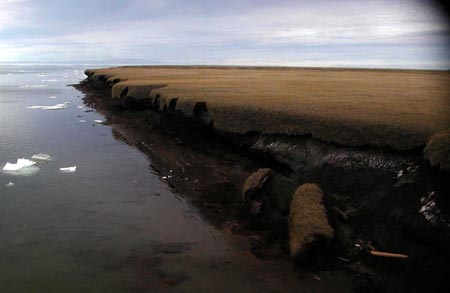The thawing of permafrost in northern latitudes, which greatly increases microbial decomposition of carbon compounds in soil, will dominate other effects of warming in the region and could become a major force promoting the release of carbon dioxide and thus further warming, according to a new assessment in the September issue of BioScience.
|

|
|
A handout photo from 2004 shows coastal erosion of mud-rich permafrost along on Beaufort Sea coastline Drew Point in Alasaka. (Xinhua/Reuters Photo) |
The study, by an international team of researchers, more than doubles previous estimates of the amount of carbon stored in the permafrost: the new figure is equivalent to twice the total amount of atmospheric carbon dioxide.
The authors conclude that releases of the gas from melting permafrost could amount to roughly half those resulting from global land-use change during this century.
Researchers refine earlier assessments by considering complex processes that mix soil from different depths during melting and freezing of permafrost, which occur to some degree every year.
They judge that over millennia, soil processes have buried and frozen over a trillion metric tons of organic compounds in the world's vast permafrost regions.
The relatively rapid warming now under way is bringing the organic material back into the ecosystem, in part by turning over soil, said the researchers.
(Xinhua News Agency September 2, 2008)